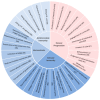The Chemokine CXCL14 as a Potential Immunotherapeutic Agent for Cancer Therapy
- PMID: 38400076
- PMCID: PMC10892169
- DOI: 10.3390/v16020302
The Chemokine CXCL14 as a Potential Immunotherapeutic Agent for Cancer Therapy
Abstract
There is great enthusiasm toward the development of novel immunotherapies for the treatment of cancer, and given their roles in immune system regulation, chemokines stand out as promising candidates for use in new cancer therapies. Many previous studies have shown how chemokine signaling pathways could be targeted to halt cancer progression. We and others have revealed that the chemokine CXCL14 promotes antitumor immune responses, suggesting that CXCL14 may be effective for cancer immunotherapy. However, it is still unknown what mechanism governs CXCL14-mediated antitumor activity, how to deliver CXCL14, what dose to apply, and what combinations with existing therapy may boost antitumor immune responses in cancer patients. Here, we provide updates on the role of CXCL14 in cancer progression and discuss the potential development and application of CXCL14 as an immunotherapeutic agent.
Keywords: CXCL14; chemokine; immunotherapy.
Conflict of interest statement
The authors declare no conflict of interest.
Figures




Similar articles
-
The multifarious roles of the chemokine CXCL14 in cancer progression and immune responses.Mol Carcinog. 2020 Jul;59(7):794-806. doi: 10.1002/mc.23188. Epub 2020 Mar 24. Mol Carcinog. 2020. PMID: 32212206 Free PMC article. Review.
-
Suppression of Antitumor Immune Responses by Human Papillomavirus through Epigenetic Downregulation of CXCL14.mBio. 2016 May 3;7(3):e00270-16. doi: 10.1128/mBio.00270-16. mBio. 2016. PMID: 27143385 Free PMC article.
-
Chemokine CXCL14; a double-edged sword in cancer development.Int Immunopharmacol. 2021 Aug;97:107681. doi: 10.1016/j.intimp.2021.107681. Epub 2021 Apr 28. Int Immunopharmacol. 2021. PMID: 33932697 Review.
-
Pleiotropic functions of the CXC-type chemokine CXCL14 in mammals.J Biochem. 2012 May;151(5):469-76. doi: 10.1093/jb/mvs030. Epub 2012 Mar 20. J Biochem. 2012. PMID: 22437940 Review.
-
CXCL14 Preferentially Synergizes With Homeostatic Chemokine Receptor Systems.Front Immunol. 2020 Oct 5;11:561404. doi: 10.3389/fimmu.2020.561404. eCollection 2020. Front Immunol. 2020. PMID: 33123134 Free PMC article.
Cited by
-
Chemokines: humble yet mighty players in the tumour microenvironment.Front Immunol. 2025 Aug 7;16:1601756. doi: 10.3389/fimmu.2025.1601756. eCollection 2025. Front Immunol. 2025. PMID: 40852716 Free PMC article. Review.
-
Blood metabolites mediate the causal relationship between circulating CX3CL1 levels and prostate cancer: A 2-step Mendelian randomization study.Medicine (Baltimore). 2024 Jun 7;103(23):e38433. doi: 10.1097/MD.0000000000038433. Medicine (Baltimore). 2024. PMID: 38847691 Free PMC article.
-
Uremic toxin receptor NR1H3 contributes to hyperlipidemia- and chronic kidney disease-accelerated vascular inflammation, which is partially suppressed by novel YBX2 anti-ROS pathway.Redox Biol. 2025 Sep;85:103724. doi: 10.1016/j.redox.2025.103724. Epub 2025 Jun 9. Redox Biol. 2025. PMID: 40505347 Free PMC article.
-
The role of the CXC chemokine family in endometriosis research and its therapeutic potential.J Mol Histol. 2025 Jun 28;56(4):211. doi: 10.1007/s10735-025-10512-5. J Mol Histol. 2025. PMID: 40580368 Review.
-
Human Papillomavirus Carcinogenicity and the Need of New Perspectives: Thoughts from a Retrospective Analysis on Human Papillomavirus Outcomes Conducted at the Hospital University of Bari, Apulia, Italy, between 2011 and 2022.Diagnostics (Basel). 2024 May 6;14(9):968. doi: 10.3390/diagnostics14090968. Diagnostics (Basel). 2024. PMID: 38732382 Free PMC article.
References
Publication types
MeSH terms
Substances
Grants and funding
LinkOut - more resources
Full Text Sources
Medical
Molecular Biology Databases

